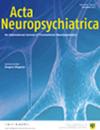Research and Diagnostic Algorithmic Rules (RADAR) for mood disorders, recurrence of illness, suicidal behaviors, and the patients lifetime trajectory
IF 2.5
4区 医学
Q1 Medicine
引用次数: 6
Abstract
The top-down DSM/ICD categories of mood disorders are inaccurate, and their dogmatic nature precludes both deductive (as indisputable) and inductive (as top-down) remodeling of case definitions. In trials, psychiatric rating scale scores employed as outcome variables are invalid and rely on folk psychology-like narratives. Using machine learning techniques we developed a new precision nomothetic model of mood disorders with a recurrence of illness (ROI) index, a new endophenotype class, namely Major Dysmood Disorder (MDMD), characterized by increased ROI, a more severe phenome, and more disabilities Nonetheless, our previous studies did not compute Research and Diagnostic Algorithmic Rules (RADAR) to diagnose MDMD and score ROI, lifetime (LT), and current suicidal behaviors, as well as the phenome of mood disorders. Here we provide rules to compute bottom-up RADAR scores for MDMD, ROI, lifetime (LT) and current suicidal SI and SA, the phenome of mood disorders, and the lifetime trajectory of mood disorder patients from a family history of mood disorders and substance abuse to adverse childhood experiences, ROI, and the phenome. We also demonstrate how to plot the 12 major scores in a single RADAR graph, which displays all features in a two-dimensional plot. These graphs allow the characteristics of a patient to be displayed as an idiomatic fingerprint, allowing one to estimate the key traits and severity of the illness at a glance. Consequently, biomarker research into mood disorders should use our RADAR scores to examine pan-omics data, which should be used to enlarge our precision models and RADAR graph.情绪障碍、疾病复发、自杀行为和患者生命轨迹的研究和诊断算法规则(RADAR)
自上而下的DSM/ICD对情绪障碍的分类是不准确的,它们的教条性质排除了对病例定义的演绎(无可争议)和归纳(自上而下)重塑。在试验中,作为结果变量的精神病学评定量表分数是无效的,并且依赖于民间心理学类的叙述。使用机器学习技术,我们开发了一种新的具有疾病复发(ROI)指数的情绪障碍的精确形态模型,这是一种新的内表型分类,即重度情绪障碍(MDMD),其特征是ROI增加,表型更严重,残疾更多。然而,我们之前的研究没有计算研究和诊断算法规则(RADAR)来诊断MDMD并对ROI、寿命(LT)和当前自杀行为进行评分。以及情绪障碍的表现。在这里,我们提供了规则来计算自底向上的RADAR评分,包括MDMD, ROI,终生(LT)和当前的自杀性SI和SA,情绪障碍的现象,以及情绪障碍患者的一生轨迹,从情绪障碍和药物滥用的家族史到不良的童年经历,ROI和现象。我们还演示了如何在单个RADAR图中绘制12个主要分数,该图在二维图中显示所有特征。这些图表可以将患者的特征显示为惯用的指纹,让人们一眼就能估计出疾病的关键特征和严重程度。因此,情绪障碍的生物标志物研究应该使用我们的RADAR评分来检查泛组学数据,这应该用于扩大我们的精度模型和RADAR图。
本文章由计算机程序翻译,如有差异,请以英文原文为准。
求助全文
约1分钟内获得全文
求助全文
来源期刊

Acta Neuropsychiatrica
医学-精神病学
CiteScore
8.50
自引率
5.30%
发文量
30
审稿时长
6-12 weeks
期刊介绍:
Acta Neuropsychiatrica is an international journal focussing on translational neuropsychiatry. It publishes high-quality original research papers and reviews. The Journal''s scope specifically highlights the pathway from discovery to clinical applications, healthcare and global health that can be viewed broadly as the spectrum of work that marks the pathway from discovery to global health.
 求助内容:
求助内容: 应助结果提醒方式:
应助结果提醒方式:


